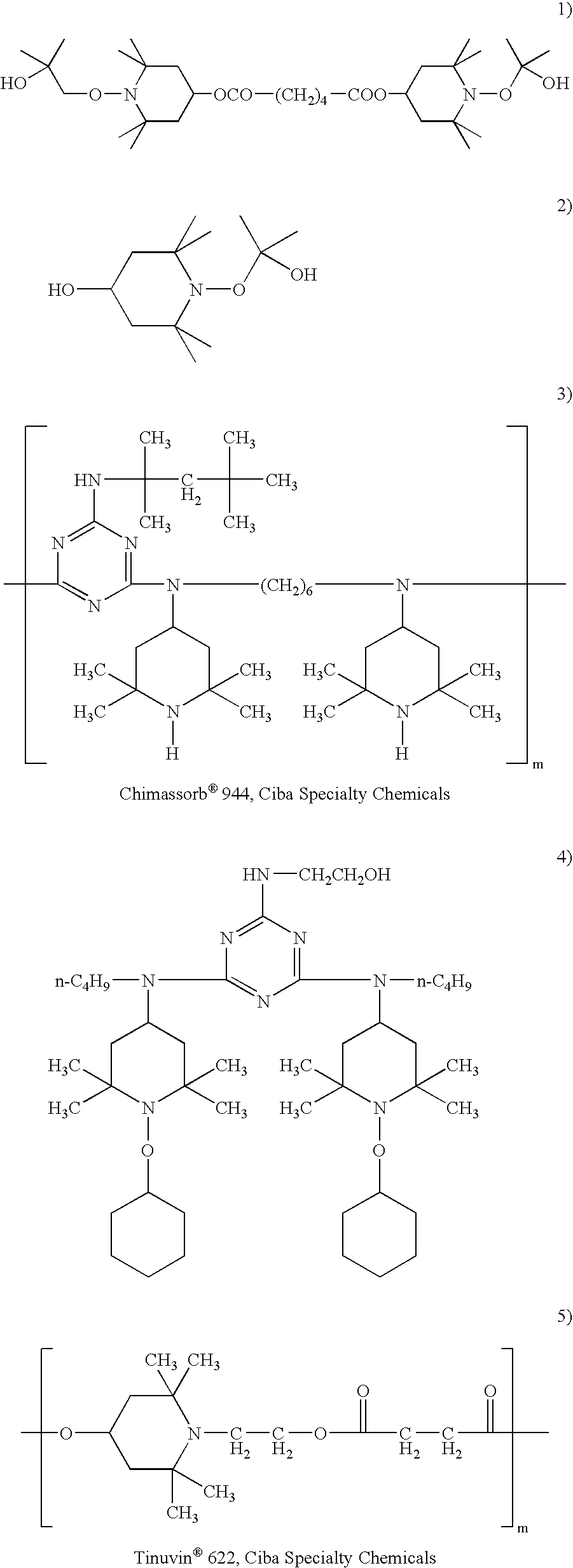Sunless tanning compositions comprising certain substituted polyamine compounds and methods of use
a technology of substituted polyamine compounds and compositions, applied in the field of cosmetics and/or dermatological compositions, can solve the problems of skin cancer, cumulative and potentially serious, and the damage of sunlight and other sources of ultraviolet radiation on the skin
- Summary
- Abstract
- Description
- Claims
- Application Information
AI Technical Summary
Problems solved by technology
Method used
Image
Examples
example 1
Condensation Polymer from L-Lysine and 2-[2′-Hydroxy-3′-t-butyl-5′-(2-methoxycarbonyl ethyl)phenyl]-benzotriazole (Benzotriazole UV Absorber)
[0142]Into a 250 ml three-neck round bottom flask is placed L-Lysine (100 g, 0.54 mol, Aldrich) and NaOH (43.8 g, 0.54 mol, 50% assay) is added over 20 minutes with stirring which becomes a milky white mixture. The reaction temperature is initially at 115 C but increased to 150 C. At this temperature, phosphoric acid (3.8 g, 85%, 33.0 mmol) is added to the mixture and the temperature is increased to 170 C under vacuum. The water in the reaction mixture is azeotroped over along with some from the reaction mass as the temperature reaches 170 C. The reaction mixture is heated and stirred for two hours under increasing vacuum. After which, 2-[2′-Hydroxy-3′-t-butyl-5′-(2-methoxycarbonyl ethyl)phenyl]-benzotriazole (BZT) (42.1 g, 0.117 mol, Ciba) is added to the mixture with stirring; the temperature drops to 140 C. The reaction temperature is gradua...
example 2
Condensation Polymer from L-Lysine and 2-[2′-Hydroxy-3′-t-butyl-5′-(2-methoxycarbonyl ethyl)phenyl]-benzotriazole (Benzotriazole UV Absorber)
[0143]Into a 250 ml three-neck round bottom flask is placed L-Lysine (100 g, 0.54 mol, Aldrich) and NaOH (21.9 g, 0.27 mol, 50% assay) is added over 20 minutes with stirring which becomes a milky white mixture. The reaction temperature is initially at 115 C but increased to 150 C. At this temperature, phosphoric acid (1.9 g, 85%, 16.5 mmol) is added to the mixture and the temperature is increased to 170 C under vacuum. The water in the reaction mixture is azeotroped over along with some from the reaction mass as the temperature reaches 170 C. The reaction mixture is heated and stirred for two hours under increasing vacuum. After which, 2-[2′-Hydroxy-3′-t-butyl-5′-(2-methoxycarbonyl ethyl)phenyl]-benzotriazole (BZT) (12.3 g, 0.034 mol, Ciba) is added to the mixture with stirring; the temperature drops to 140 C. The reaction temperature is gradua...
example 3
Condensation Polymer from L-Lysine and Methyl 3,5-di-tert-butyl-4-hydroxyhydrocinnamate (Phenolic Antioxidant)
[0144]Into a 250 ml three-neck round bottom flask is placed L-Lysine (50.0 g, 0.27 mol, Aldrich) and NaOH (21.9 g, 0.27 mol, 50% assay) is added over 20 minutes with stirring which becomes a milky white mixture. The reaction temperature is initially at 115 C but increased to 150 C. At this temperature, phosphoric acid (1.9 g, 85%, 16.5 mmol) is added slowly to the mixture and heated to 170 C. under vacuum. The water in the reaction mixture is azeotroped over along with some from the reaction mass as the temperature reaches 170 C. The reaction mixture is heated and stirred for two hours under increasing vacuum. After which, methyl 3,5-di-tert-butyl-4-hydroxyhydrocinnamate (25 g, 0.05 mol, Ciba) is added to the mixture with stirring; the temperature drops to 140 C. The reaction temperature is gradually increased to 195 C and is held there for 2 hours. The progress of the conde...
PUM
| Property | Measurement | Unit |
|---|---|---|
| Fraction | aaaaa | aaaaa |
| Fraction | aaaaa | aaaaa |
| Fraction | aaaaa | aaaaa |
Abstract
Description
Claims
Application Information
 Login to View More
Login to View More - R&D
- Intellectual Property
- Life Sciences
- Materials
- Tech Scout
- Unparalleled Data Quality
- Higher Quality Content
- 60% Fewer Hallucinations
Browse by: Latest US Patents, China's latest patents, Technical Efficacy Thesaurus, Application Domain, Technology Topic, Popular Technical Reports.
© 2025 PatSnap. All rights reserved.Legal|Privacy policy|Modern Slavery Act Transparency Statement|Sitemap|About US| Contact US: help@patsnap.com



